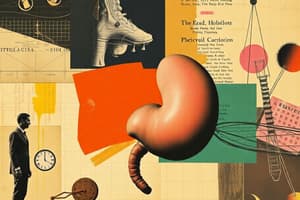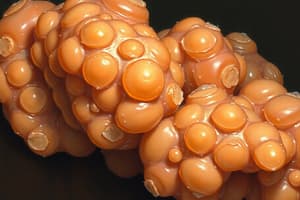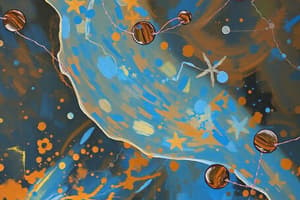Podcast
Questions and Answers
What is the net utilization of high-energy bonds when a fatty acid molecule is activated?
What is the net utilization of high-energy bonds when a fatty acid molecule is activated?
- One ATP molecule is converted to ADP.
- Two ATP molecules are converted to AMP.
- One ATP molecule is converted to AMP. (correct)
- Two ATP molecules are converted to ADP.
In the context of fatty acid oxidation, where does the conversion of fatty acyl-CoA to acyl-carnitine occur?
In the context of fatty acid oxidation, where does the conversion of fatty acyl-CoA to acyl-carnitine occur?
- Cytoplasm
- Inner mitochondrial membrane (correct)
- Mitochondrial matrix
- Outer mitochondrial membrane
What is the significance of the β-carbon in β-oxidation of fatty acids?
What is the significance of the β-carbon in β-oxidation of fatty acids?
- It undergoes successive oxidations in the removal of two carbon atoms. (correct)
- It is the point of attachment of coenzyme A.
- It is the carbon atom at the carboxyl end of the fatty acyl-CoA.
- It is the carbon atom where the double bond is formed during desaturation.
What is the primary energy source for the brain when the body is in a state of starvation for more than 4 days?
What is the primary energy source for the brain when the body is in a state of starvation for more than 4 days?
Carnitine, essential for fatty acid transport into mitochondria, is derived from which amino acids?
Carnitine, essential for fatty acid transport into mitochondria, is derived from which amino acids?
What condition arises when ketone bodies accumulate in the body at a high rate, overwhelming the kidney's ability to remove them?
What condition arises when ketone bodies accumulate in the body at a high rate, overwhelming the kidney's ability to remove them?
Which of the following is NOT a ketone body produced by the liver?
Which of the following is NOT a ketone body produced by the liver?
What is the primary effect of a low-carbohydrate, high-protein diet on the body's energy production?
What is the primary effect of a low-carbohydrate, high-protein diet on the body's energy production?
Which of the following conditions cause the body to rely more heavily on fatty acids for energy?
Which of the following conditions cause the body to rely more heavily on fatty acids for energy?
What is the primary role of ketone bodies in the body?
What is the primary role of ketone bodies in the body?
Which of the following is NOT a substrate used by the liver for gluconeogenesis?
Which of the following is NOT a substrate used by the liver for gluconeogenesis?
What is the primary role of the liver in response to low blood glucose levels?
What is the primary role of the liver in response to low blood glucose levels?
What process is triggered in the liver to supply glucose to the brain during starvation or a low-carbohydrate diet?
What process is triggered in the liver to supply glucose to the brain during starvation or a low-carbohydrate diet?
Besides the two primary ketone bodies (acetoacetate and beta-hydroxybutyrate), what is the third ketone body produced by the liver?
Besides the two primary ketone bodies (acetoacetate and beta-hydroxybutyrate), what is the third ketone body produced by the liver?
What is the primary reason why ketone bodies can accumulate in the body during a ketogenic diet?
What is the primary reason why ketone bodies can accumulate in the body during a ketogenic diet?
What is the role of insulin in regulating blood glucose levels?
What is the role of insulin in regulating blood glucose levels?
What is one major function of fats in the body?
What is one major function of fats in the body?
Which of the following statements about fatty acids is true?
Which of the following statements about fatty acids is true?
How many calories do fats provide per gram?
How many calories do fats provide per gram?
Which of the following is NOT a role of fats in the human body?
Which of the following is NOT a role of fats in the human body?
Which types of fatty acids are essential for health?
Which types of fatty acids are essential for health?
What component is primarily responsible for storing fats in the body?
What component is primarily responsible for storing fats in the body?
Which hormone is primarily secreted during physical activity to mobilize energy?
Which hormone is primarily secreted during physical activity to mobilize energy?
What is the correct order of the enzymatic steps involved in the mobilization of TAGs?
What is the correct order of the enzymatic steps involved in the mobilization of TAGs?
What role does glucagon play in fat metabolism?
What role does glucagon play in fat metabolism?
What is the main function of lipase in fat digestion?
What is the main function of lipase in fat digestion?
In what context does insulin inhibit lipolysis most effectively?
In what context does insulin inhibit lipolysis most effectively?
Which of these substances contributes to fat absorption in the intestine?
Which of these substances contributes to fat absorption in the intestine?
During which condition is triacylglycerol mobilization most crucial?
During which condition is triacylglycerol mobilization most crucial?
Which hormone is primarily released during fasting or low blood glucose levels?
Which hormone is primarily released during fasting or low blood glucose levels?
What is the role of cyclic AMP (cAMP) in lipolysis?
What is the role of cyclic AMP (cAMP) in lipolysis?
Which enzyme hydrolyzes triglycerides (TAGs) into diacylglycerols (DAGs) and free fatty acids (FFAs)?
Which enzyme hydrolyzes triglycerides (TAGs) into diacylglycerols (DAGs) and free fatty acids (FFAs)?
What is the first step in the oxidation of fatty acids?
What is the first step in the oxidation of fatty acids?
What is the function of perilipin in the lipolysis process?
What is the function of perilipin in the lipolysis process?
Which of the following describes the transport process of free fatty acids (FFAs) after lipolysis?
Which of the following describes the transport process of free fatty acids (FFAs) after lipolysis?
What is the primary enzyme activated by cAMP during lipolysis?
What is the primary enzyme activated by cAMP during lipolysis?
What is the outcome of monoacylglycerol lipase (MAGL) activity during lipolysis?
What is the outcome of monoacylglycerol lipase (MAGL) activity during lipolysis?
Flashcards
What are lipids?
What are lipids?
A type of lipid that includes fats, oils, waxes, phospholipids and steroids.
What are the functions of fats in our bodies?
What are the functions of fats in our bodies?
Fats are important as carriers of other nutrients (like vitamins) and contribute to the flavor of our food. However, their consumption should be monitored due to their high energy content.
What is the primary function of fats in our bodies?
What is the primary function of fats in our bodies?
Fats are a concentrated source of energy, providing 9 kcal per gram, making them efficient energy storage molecules in our body.
What is the general structure of a fatty acid?
What is the general structure of a fatty acid?
Signup and view all the flashcards
What are the main functions of fatty acids?
What are the main functions of fatty acids?
Signup and view all the flashcards
Fatty Acid
Fatty Acid
Signup and view all the flashcards
Saturated Fatty Acid
Saturated Fatty Acid
Signup and view all the flashcards
Unsaturated Fatty Acid
Unsaturated Fatty Acid
Signup and view all the flashcards
Fat Mobilization
Fat Mobilization
Signup and view all the flashcards
Lipase
Lipase
Signup and view all the flashcards
Glucagon
Glucagon
Signup and view all the flashcards
Epinephrine (Adrenaline)
Epinephrine (Adrenaline)
Signup and view all the flashcards
Insulin
Insulin
Signup and view all the flashcards
Lipolysis
Lipolysis
Signup and view all the flashcards
Triggering Hormones in Lipolysis
Triggering Hormones in Lipolysis
Signup and view all the flashcards
Hormone Receptors in Lipolysis
Hormone Receptors in Lipolysis
Signup and view all the flashcards
G Protein (Gs protein) in Lipolysis
G Protein (Gs protein) in Lipolysis
Signup and view all the flashcards
Adenylyl Cyclase in Lipolysis
Adenylyl Cyclase in Lipolysis
Signup and view all the flashcards
Cyclic AMP (cAMP) in Lipolysis
Cyclic AMP (cAMP) in Lipolysis
Signup and view all the flashcards
Protein Kinase A (PKA) in Lipolysis
Protein Kinase A (PKA) in Lipolysis
Signup and view all the flashcards
Lipolysis Initiation
Lipolysis Initiation
Signup and view all the flashcards
What is β-oxidation?
What is β-oxidation?
Signup and view all the flashcards
What is carnitine?
What is carnitine?
Signup and view all the flashcards
What is gluconeogenesis?
What is gluconeogenesis?
Signup and view all the flashcards
What are ketone bodies?
What are ketone bodies?
Signup and view all the flashcards
How are fatty acids activated?
How are fatty acids activated?
Signup and view all the flashcards
What is carnitine acyltransferase?
What is carnitine acyltransferase?
Signup and view all the flashcards
What is the role of coenzyme A (CoA) in fatty acid metabolism?
What is the role of coenzyme A (CoA) in fatty acid metabolism?
Signup and view all the flashcards
What is ketosis?
What is ketosis?
Signup and view all the flashcards
How are ketone bodies produced?
How are ketone bodies produced?
Signup and view all the flashcards
What is the role of ketone bodies in starvation?
What is the role of ketone bodies in starvation?
Signup and view all the flashcards
What are the risks of high ketone body levels?
What are the risks of high ketone body levels?
Signup and view all the flashcards
How do keto diets work?
How do keto diets work?
Signup and view all the flashcards
How are ketone bodies related to type 1 diabetes?
How are ketone bodies related to type 1 diabetes?
Signup and view all the flashcards
What is the role of the liver in diabetes and ketone body production?
What is the role of the liver in diabetes and ketone body production?
Signup and view all the flashcards
How are ketone bodies eliminated from the body?
How are ketone bodies eliminated from the body?
Signup and view all the flashcards
Study Notes
Fatty Acid Catabolism
- Fats are crucial components of many bodily tissues and important for carrying other nutrients, including vitamins. Fat consumption should be monitored.
- Lipids include phospholipids, triglycerides, and cholesterol, contributing to cell membrane structure.
- Fats in the diet provide energy (9 kcal per gram), insulate and protect organs, and are essential for absorbing fat-soluble vitamins (A, D, E, K).
- Sources of dietary fat include eggs, avocados, sardines, pistachios, walnuts, almonds, olive oil, and nut butter.
Contents of Fatty Acid Catabolism
- Introduction to fatty acids
- Digestion, mobilization, and transport of fats
- Oxidation of fatty acids
- Ketone bodies
Introduction to Fatty Acids
- Fats are composed of carbon, hydrogen, and oxygen.
- A fat molecule includes glycerol with attached fatty-acid chains.
- Different types of fats have various fatty acids bound to glycerol.
Classification of Fatty Acids
- Saturated: No double bonds, solid at room temperature (e.g., butyric acid, palmitoleic acid, stearic acid).
- Unsaturated: One or more double bonds;
- Essential: Omega-3 (e.g. α-linolenic acid), ω-6 (e.g. linoleic acid), EPA, and DHA.
- Non-essential: ω-9 (e.g. Oleic acid), GLA.
Digestion, Mobilization, and Transport of Fats
- Dietary triacylglycerols are a significant energy source, contributing about one-third of energy requirements.
- The liver and heart utilize fatty acids for roughly 80% of their energy needs.
- Hibernating animals often rely almost exclusively on fat reserves for sustained energy (and water) during long periods of dormancy.
Hormonal Trigger Mobilization of Stored Triacylglycerols
- Hydrolysis of TAGs is catalyzed by lipases, generating MAGs, DAGs, FFAs, and glycerol.
- Lipases are regulated by hormones like epinephrine ("we need energy now") and glucagon ("we're out of glucose").
Mechanism of TAG Mobilization
- Step 1: Hormonal activation. Epinephrine/adrenaline (during stress/exercise), and glucagon (during fasting/low blood glucose).
- Step 2: Activation of Adenylyl Cyclase. Hormone-receptor interaction activates G-protein (specifically Gs protein), which stimulates adenylyl cyclase. This enzyme converts ATP to cyclic AMP (cAMP).
- Step 3: Activation of Protein Kinase A (PKA). cAMP activates PKA, which phosphorylates target proteins, initiating lipolysis. Hormone-sensitive lipase (HSL) and perilipin are targeted proteins.
- Step 4: Lipolysis Initiation. Perilipin phosphorylation restructures the lipid droplet, causing TAGs to become exposed to lipases. Adipocyte triglyceride lipase (ATGL) breaks down TAGs into free fatty acids (FFAs) and diacylglycerol. Hormone-sensitive lipase (HSL) further breaks down diacylglycerol to MAGs and FFAs. Monoacylglycerol lipase (MAGL) converts MAG to glycerol.
- Step 5: Release of Products. Free fatty acids (FFAs) are released into the bloodstream, bound to albumin, and taken up by muscle and liver tissues for beta-oxidation and ATP production. Glycerol is transported to the liver and used in gluconeogenesis or glycolysis.
Fat Transport into Mitochondria
- Fatty acids are transported or pass into mitochondria. Smaller fatty acids (less than 12 carbons) diffuse freely. Larger fatty acids are transported using a carnitine shuttle, which utilizes carnitine acyltransferase I in the cytosol and carnitine acyltransferase II in the mitochondria.
Conversion of Fatty Acid to Fatty Acyl-CoA
- Fatty acids are activated and converted to fatty acyl-CoA by acyl-CoA synthetase. This process requires ATP.
IV. Oxidation of Fatty Acids
- Fatty acid oxidation occurs in the mitochondrial matrix.
- The process breaks down fatty acids into two-carbon acetyl-CoA units.
- Oxidative conversion involves four steps or stages in each cycle to produce NADH, FADH₂ and acetyl-CoA.
- Acetyl-CoA then enters the citric acid cycle.
- The final two steps use the electron transport chain to get ATP from NADH and FADH2
V. Ketone Bodies
- Ketone bodies (acetoacetate, beta-hydroxybutyrate, and acetone) are produced by the liver during gluconeogenesis, when glucose supply is low or absent.
- They are used by the body for energy, particularly by the brain during fasting or starvation.
- The production and usage of ketone bodies are tightly regulated and influenced by dietary intake, metabolic states (like exercise and diabetes), and more.
- Untreated diabetes may cause a build-up of ketone bodies, leading to ketoacidosis, a potentially serious condition.
Studying That Suits You
Use AI to generate personalized quizzes and flashcards to suit your learning preferences.




